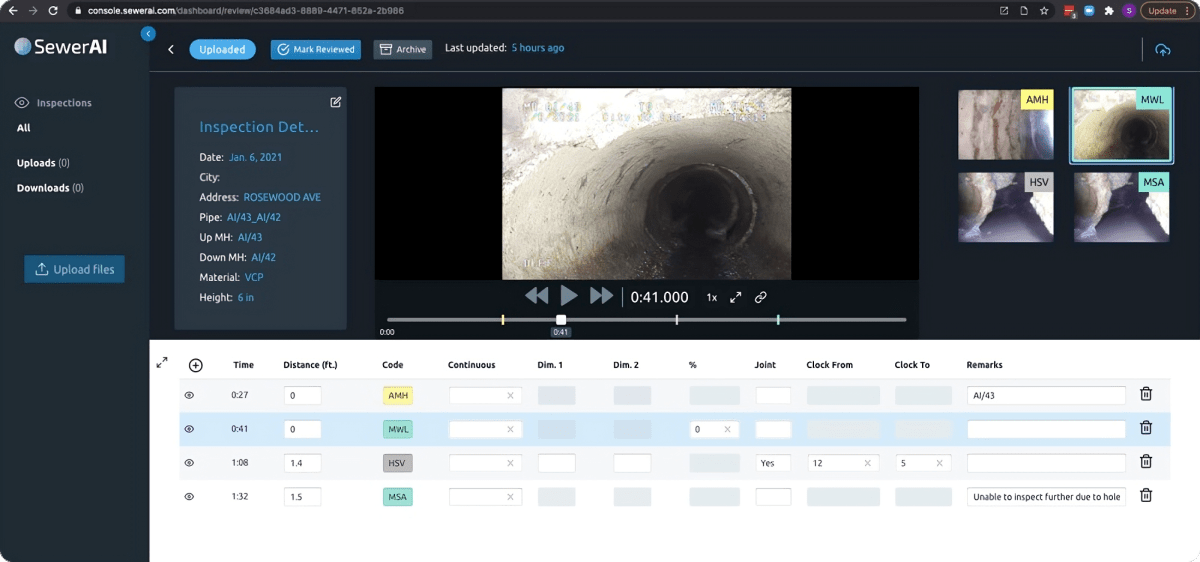Climate change is raising the risk, rate and cost of sewage failures. Floods are becoming more common, leading to backups that frequently overwhelm wastewater treatment systems. Exacerbating the issue, America’s infrastructure is woefully outdated; the EPA estimates that nearly $700 billion in investments is needed to simply maintain existing wastewater, stormwater and other clean water pipelines over the next 20 years.
Matthew Rosenthal and Billy Gilmartin, both of whom hail from the wastewater treatment industry, saw an opportunity to help solve the problem with tech — in a small way, at least. Five years ago, the pair co-founded SewerAI, which taps AI to automate the types of data capture and defect tagging that make up a sewer inspection.
“Most infrastructure was built post-WW2 and is reaching the end of its useful life, leading to more frequent failures and increased costs,” Rosenthal told TechCrunch. “SewerAI revolutionizes underground infrastructure inspection and management with its AI-driven software-as-a-service platform.”
SewerAI began as Rosenthal’s side project; he’d started taking online courses on AI after co-launching two wastewater analysis and services firms. While experimenting with AI models to predict sewer defects in inspection videos, Rosenthal recruited the help of Gilmartin, who was working at a sewer inspection company at the time.

Today, SewerAI — whose customers span municipalities, utilities and private contractors — sells cloud-based, AI-powered subscription products designed to streamline field inspections and data management of sewer infrastructure.
One of those products, Pioneer, allows field inspectors to upload inspection data to the cloud and tag issues — data that project managers can then use to plan fixes to pipes. Another tool, AutoCode, automatically tags inspections of pipes and manholes, creating 3D models of infrastructure from videos captured on a GoPro or other camera.
“Legacy incumbents offer on-premise or on-truck software that has seen very little innovation in the last 20 years,” Rosenthal said. “SewerAI’s technology increases top and bottom lines by enabling more inspections per day at a lower cost.”
SewerAI isn’t alone in the nascent market for AI-assisted pipe inspection. The company’s rivals include Subterra, which maps, analyzes and forecasts problems with pipelines; Clear Object, which offers software that analyzes footage from pipe inspections for damage; and Pallon, which develops algorithms to spot potential problems inside sewers from still images.

What sets SewerAI apart, Rosenthal claims, is the quality of its data — specifically the quality of its model training data. Rosenthal says that SewerAI has footage of inspections of 135 million feet of pipes from municipalities and independent contractors. While just a fraction of the 6.8 billion feet of sewer pipes in the U.S., it’s a large enough data set to train a competitive defect-detecting AI, Rosenthal says.
“Our products streamline field inspections and data management, enabling clients to proactively manage infrastructure instead of reacting to emergencies,” Rosenthal said.
SewerAI’s sales pitch won over investors like Innovius Capital, who along with others poured $15 million into SewerAI’s most recent fundraising round. Bringing SewerAI’s total raised to $25 million, the cash will be put toward go-to-market expansion, AI model training, hiring and expanding SewerAI’s product portfolio beyond inspection tools.
“SewerAI is continuing to grow, and we’re seeing an acceleration in demand for our platform as we enable people to do more with existing budgets, which has resulted in us closing our first seven-figure contracts,” Rosenthal said.
